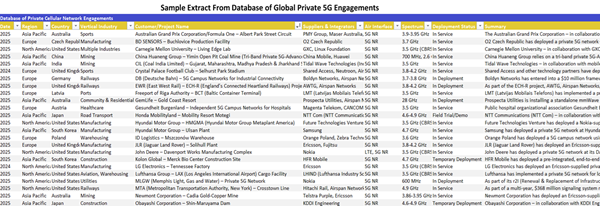Company Logo
The rise of private 5G networks, driven by enhanced capabilities like URLLC and mMTC, presents opportunities in sectors like manufacturing, mining, and public safety. With global deployment expanding and companies like Tesla and Hyundai showcasing efficiency and cost benefits, private 5G is poised for significant growth.
Sample Extract
Sample Extract
Dublin, Sept. 15, 2025 (GLOBE NEWSWIRE) — The “Private 5G Network Deployment Tracker & Forecasts 2025-2030” database from SNS Telecom & IT has been added to ResearchAndMarkets.com’s offering.
Annual investments in private 5G networks for vertical industries will grow at a CAGR of approximately 41% between 2025 and 2028, eventually surpassing $5 billion by the end of 2028.
The “Private 5G Network Deployment Tracker & Forecasts: 2025-2030” datasheet includes an extensive database of over 8,300 global private cellular network engagements across 130 countries including more than 3,700 private 5G installations as of Q3’2025. In addition, it provides global and regional market size forecasts for private 5G network investments from 2025 to 2030. The forecasts cover three infrastructure submarkets, 16 vertical industries, and five regional markets.
Although much of this growth will initially be driven by highly localized 5G networks covering geographically limited areas for Industry 4.0 applications in manufacturing and process industries, sub-1 GHz wide area critical communications networks for public safety, utility, and railway communications are anticipated to accelerate their transition from LTE, GSM-R, and other legacy narrowband technologies to 5G towards the latter half of the forecast period.
Private LTE networks are a well-established market and have been around for more than a decade, albeit as a niche segment of the wider cellular infrastructure sector. However, private cellular networks or NPNs (Non-Public Networks) based on 3GPP-defined 5G specifications are just on the cusp of becoming a mainstream technology, with a market potential exceeding that of private LTE. Over the last 12 months, there has been a noticeable increase in production-grade deployments of private 5G networks by household names and industrial giants such as Airbus, Aker BP, Boliden, CIL (Coal India Limited), Equinor, Etihad, Ford, Hutchison Ports, Hyundai, Jaguar Land Rover, John Deere, LG Electronics, Lufthansa, Newmont, POSCO, Tesla, Toyota, and Walmart, paving the way for Industry 4.0 and advanced application scenarios.
Compared to LTE technology, private 5G networks can address far more demanding performance requirements in terms of throughput, latency, reliability, availability, and connection density. In particular, 5G’s URLLC (Ultra-Reliable, Low-Latency Communications) and mMTC (Massive Machine-Type Communications) capabilities, along with a future-proof transition path to 6G networks in the 2030s, have positioned it as a viable alternative to physically wired connections for industrial-grade communications between machines, robots, and control systems. Furthermore, 5G’s wider coverage radius per radio node, scalability, determinism, security features, and mobility support have stirred strong interest in its potential as a replacement for interference-prone unlicensed wireless technologies in IIoT (Industrial IoT) environments, where the number of connected sensors and other endpoints is expected to increase significantly over the coming years.
Story Continues
As end user organizations in the United States, Canada, Germany, United Kingdom, France, China, Japan, South Korea, Taiwan, Australia, Brazil, and other countries ramp up their digitization and automation initiatives, private 5G installations have progressed to a stage where practical and tangible benefits particularly efficiency gains, cost savings, and worker safety are becoming increasingly evident.
For instance, Tesla, LG Electronics, and Hyundai have eliminated connection-related stoppages since migrating AGV (Automated Guided Vehicle) and AMR (Autonomous Mobile Robot) communications from unlicensed Wi-Fi systems to private 5G networks at their production facilities in the United States and South Korea. The French city of Istres has reduced video surveillance camera installation costs from $34,000 to less than $6,000 per unit by replacing fiber-based connections with a private 5G network. Among other examples, China Huaneng Group relies on a tri-band (700 MHz, 2.6 GHz & 4.9 GHz) 5G-Advanced network to safely coordinate a fleet of 100 unmanned electric mining trucks at its Yimin open pit coal mine in Inner Mongolia, China.
Database Details & Forecast Segmentation
The following details are included in the global database of private cellular network engagements:
Date
Region
Country
Vertical Industry
Customer/Project Name
Suppliers & Integrators
Air Interface Technology
Spectrum
Deployment Status
Summary
Market forecasts are provided for each of the following submarkets and their subcategories:
Infrastructure Submarkets
5G NR RAN (Radio Access Network)
5GC (5G Core)
5G Transport (Fronthaul, Midhaul & Backhaul)
Fiber & Wireline
Microwave
Satellite Communications
Cell Sizes
Frequency Ranges
Sub-6 GHz
mmWave (Millimeter Wave)
End User Markets
Regional Markets
North America
Asia-Pacific
Europe
Middle East & Africa
Latin & Central America
For more information about this database visit https://www.researchandmarkets.com/r/bzknqs
About ResearchAndMarkets.com
ResearchAndMarkets.com is the world’s leading source for international market research reports and market data. We provide you with the latest data on international and regional markets, key industries, the top companies, new products and the latest trends.
Attachment
CONTACT: CONTACT: ResearchAndMarkets.com Laura Wood,Senior Press Manager press@researchandmarkets.com For E.S.T Office Hours Call 1-917-300-0470 For U.S./ CAN Toll Free Call 1-800-526-8630 For GMT Office Hours Call +353-1-416-8900

